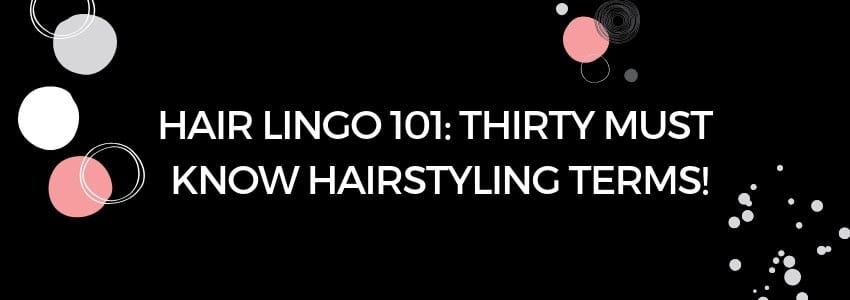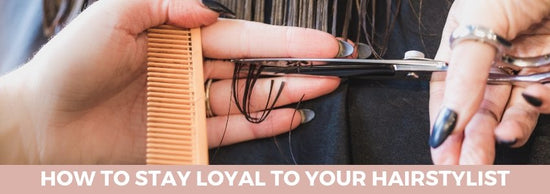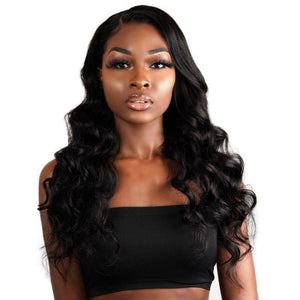Learn Hair Lingo
Knowing how to speak the language in any field is a must; the hair industry is no exception. The jargon is constantly expanding in the world of hair; the girls who get it get it, and you most certainly will after this article.
Listen up if you get your hair done or simply want to stay abreast of the 411 in the hair world-There are a few hairstyling terms that you should be aware of.
It is imperative to be aware of styling terms, whether you are a stylist or a customer. It is essential if you are a stylist to know what these terms mean so that you can offer various and specified services to your clients.
If you are a customer, being aware of various hairstyling terms can help you communicate the exact look you want with your stylist. So don't overlook these terms if you love to get your hair done.
You never know when these terms will come in handy.

Hair Extension Terms You Need to Know
We've developed a list of 30 must-know hairstyling terms to help you along the way!
Cutting
We've broken down the terms by their specific categories to make it easier for you.
There are so many ways to cut your hair. Let's first start with popular hairstyling terms for
cutting hair.
1. Asymmetrical Cut
A haircut where the hair is not symmetrical and one side is longer than the other.
2. Big Chop
The big chop is the haircut that marks the beginning of one's natural hair journey. All hair that is relaxed, colored, and chemically processed is cut off, and the remaining hair is in its natural state.
The big chop is a big deal for natural hair girls all around the world. Many naturalists all over the world can remember this big day. They take photos and write down the dates of their big chops to document their natural hair journey.
3. Fringe (Bangs)
Also known as "bangs," fringe is a haircut with some hair covering your face. Here are some bang styles worn by your favorite celebrities that you can try!

4. Graduated Cut
A graduated haircut is one that is a gradual progression of lengths from short to long. It ultimately creates a layered effect.
5. Layers
Cutting your hair into various lengths to “layer” them and create a voluminous look.
6. Pixie Cut
A woman’s layered short hairstyle that is cut to create a slightly tousled effect. From Zendaya to Rihanna are some pixie cut styles that we love!
7. Razor Cut
A hairstyle where a cut is done with a razor to create a tapered effect
8. Undercut
A bold hairstyle that leaves length on the top and sometimes sides, and the remaining back area is shaved low.
Conditions
The word conditions can mean so many different things in the world of hair. Does your hair need a good condition treatment, or do you have a hair condition? Do you know what I mean? Here are a few hair conditions you should be aware of that may affect hair growth and need treatment as soon as possible.
9. Alopecia
This is a medical hair condition where the immune system mistakenly attacks hair follicles, causing them to shed, resulting in bald patches on the scalp.
If you are experiencing hair loss, we've created the following articles to help support you through this hair condition:
Hair Loss Sucks! Tips on How To Fight It!
How Stress Can Lead to Hair Loss and What to do About It
Hair Growth: Why Isn’t My Natural Hair Growing Faster?
10. Shedding
Our hair sheds, on average, 100 strands per day; anything exceeding this amount is considered excessive shedding. Shedding is often caused by damaged hair and can cause hair loss or balding if not treated or taken care of properly.

Coloring
There are many different types of coloring techniques. Each coloring technique is used to create various effects when it comes to the contrast and color of your hair. Here are a few standard coloring techniques.
11. Balayage
A highlighting technique where you sweep color onto the surface of the hair, creating a gradual color effect for a natural look.
12. Base Color
You apply this color before adding other colors, such as highlights, to your hair.
13. Developer
The developer is hydrogen peroxide that helps open up the hair cuticles to allow hair color to penetrate through for optimal coloring results. There is 5, 10,20,30,40, and sometimes 50 volume
developer. The higher the developer, the more substantial the color results.
14. Highlights
Strands or slices of hair that are colored and wrapped in foil to make them lighter than the hair's base color, creating a dimensional look.
15. Lowlights
Strands of hair that are dyed to make them darker than the hair's base color.
16. Ombre
Ombre is a hair coloring technique where the usually natural darker shade at the root transitions into a lighter shade on the ends of the hair. Ombres can be done with various pop color combos as well.
We've got you covered if you want to achieve the ombre look.. Check out our article “DIY Ombre Hair: My First Time!” to learn how to achieve the ombre look.

Styling
With so many different types of hairstyles out there, let's go over some of the terms you need to know regarding styling hair.
17. Braid Pattern
The braid pattern is a foundation created by braiding your hair to prepare your hair for sew-in extensions. The most common is the beehive or straight back.
18. Texturizer
A milder version of a relaxer. Texturizer loosens the natural curl pattern without completely straightening it like a relaxer.
19. Touch Up
A touch-up is what it says, touching up your hair to make it look brand new again. Do touch-ups
with hair coloring, relaxers, or even braids!

Styles
Now that we've covered styling terms, let's go over hairstyles. With so many different types of hairstyles out there, let us go over some hairstyles that you may know by their look but not by their name.
20. Flat Twists
You start by sectioning hair into various sections, twisting strands, and then twisting one or two twisted strands around one another. Like braid outs, you can wear flat twists overnight or a few hours, then unraveled revealing curly hair.
21. Braid Out
A hairstyle where you take sections of hair, apply your nourishing curl-enhancing product of choice, and then begin braiding your hair. The braids are worn overnight or for a few hours and then unraveled to create a curl-like pattern within the hair.
22. Bantu Knots
A hairstyle with coiled, small buns all over the head that look like knots. This style originates from the “Bantu people” of southern and central Africa.
It is a typical hairstyle for many women of African descent and used as low maintenance or curl enhancing style for women with natural hair.

23. Lob
We are all familiar with the signature bob hairstyle. A lob is a longer version of the bob hairstyle.
24. TWA
This is an acronym for "teeny weeny afro," which you can use to describe short natural hair.
25. Virgin Hair
This is unprocessed hair or non-chemically treated hair.
Here at Private Label Extensions, we offer virgin hair at a wholesale price. Our textures range from straight, kinky curly, natural, wavy, loose waves, and more!
Wearing virgin hair has many benefits, such as its durability when it comes to styling and coloring. In addition, virgin hair is high-quality hair. It is known to last very long and is an excellent choice for various hairstyles.

Health & Treatments
Hair treatments are great when it comes to treating various hair conditions or getting your hair to be in a healthier state. Here are some hair treatments that can be used to promote the health of your hair.
26. Co-Wash
Shoutout to the natural hair community on Youtube University for creating this term. Co-wash is a method of washing your hair with conditioner instead of shampoo. This technique is used to retain moisture. Many of Naturalista's co-wash to avoid over-drying their hair.
27. Essential Oils
Natural oils such as lavender, coconut, sage, jojoba oil, etc. that, can be used on your hair to promote a healthy scalp and hair growth. Find out more about how you can use essential oils along with other products to promote healthy hair growth in our article “15 Tips to Maintaining Healthy Hair”.

28. Porosity
It is the hair's ability to absorb moisture. The cuticle layer's condition determines porosity. Hair with high porosity is usually over-processed or chemically damaged. As a result, the cuticle is open, so it absorbs moisture quickly, while hair with a low porosity level has a very healthy cuticle that lays flat and does not absorb moisture easily.
Here are some traits of high versus low porosity hair:
High Porosity
● Hair easily absorbs water
● Hair drys quickly
● Requires more products
● Frizz
● Hair may often feel and look dry
Low Porosity
● Hair takes a long time to dry
● Products build up on hair
● Natural oils don't easily penetrate, but they sit on your hair
● Curls take way longer to saturate when wet thoroughly
29. Protein Treatment
Our hair is composed primarily of a protein called keratin. Therefore, a protein treatment strengthens your hair. It also replenishes and adds extra proteins and nutrients to your hair to
promote healthy hair. You can get this treatment at a salon, or you can do it yourself at home.
Here are some signs that your hair may need a protein treatment:
● You have recently colored your hair
● Hair has lost its moisture
● Your hair has a high porosity
● Limp or stringy hair
● Low elasticity hair
● Hair feels sticky or gummy
30. Relaxer
A chemical treatment used to straighten hair. Commonly mistaken for perm, but you must be careful because the term perm is also a chemical treatment, but it is used to add curls to hair.

Speak Hair Lingo Like a Boss
I hope these definitions helped familiarize you with various hair styling terms. Knowing these terms can help you communicate in the hair world like a pro and achieve your next hairstyle so much easier.
Knowledge is always necessary; it's not only in what you do but what you say. So next time you're doing hair or having your hair styled, you can always refer to these terms.
What are some common hair terms that you know of? Please share them with us in the comments below.






